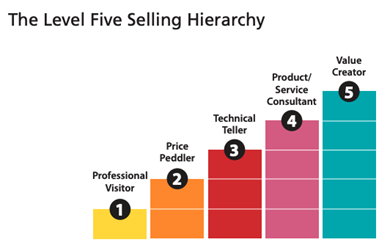
Webinar: Tuesday, April 29th @1pm
Winning at Retention-
Proven Strategies to Reduce Cancellations, Winback Customers & Drive Lifetime Value
Sign up Now

It’s a proven fact: The best salespeople are continuously improving. Top salespeople have a growth mindset and are meticulous in how they both plan for their sales calls and reflect on the calls once completed. This honest reflection is critically important as it guides them to be better next time.
Sales organizations that excel and outperform their competition have a similar dynamic. They are growth minded and invest in their sales teams’ skills as a high priority.
When I began my career in sales performance consulting, I thought our ideal customers would be those who needed help and perhaps weren’t performing at optimal levels. To my surprise, it was quite the opposite: Each customer was at the top of their game. It was clear that the best had a keen focus on quality and a deep belief that the salesperson-to-customer interaction separates them from others.
Buyer research has supported this point – how the salesperson interacts with the customer is the most significant differentiating factor, and we must get the sales interaction right.
You must have a clear definition of what a quality sales call looks like in your organization. This may sound quite simple; however, when we ask frontline sales leaders from the same company to define a quality sales interaction they, surprisingly, can’t agree. How can you ever expect to achieve quality if your frontline sales leaders can’t agree?
Next, you must ask yourself what type of sales coaching is occurring, and are you achieving consistency? Too often, this is an issue. Imagine if the leaders at Boeing couldn’t agree on what a quality output looked like when constructing a plane. Would you be excited about flying on one of their planes?
Over the years, the understanding of what constitutes excellence in selling in the B2B market has evolved. A structure that helps to visualize that evolution is what we have labeled the Level Five Selling Hierarchy. Here is a quick review of how it works.

Level One – Professional Visitor: At this level, the salesperson relies solely on the importance of relationships and rapport for achieving success.
Level Two – Price Peddler: At this next level, selling is all about price. The Level Two salesperson is only interested in winning by selling the company’s products at the lowest available price. This salesperson doesn’t sell value and doesn’t consider added value as part of the equation for winning.
Level Three – Technical Teller: Salespeople who are technically well versed are the ones who frequently conduct this level of selling. For them, selling involves telling the customer about the product features until they hit on something the customer likes. The old expression “spray and pray” was coined to describe this level of selling.
Level Four – Product/Service Consultant: Level Four is the first level of professional selling. It goes beyond price peddling and product pitches. These salespeople serve as Product/Service Consultants. They ask questions and uncover and develop needs. They address tactical problems but fail to create value because they fail to provide insights into the customers’ broader strategic business challenges and connect a purchase to addressing them.
Level Five –Value Creator: Salespeople at this top level look at the big picture from a business and strategic perspective. They possess an in-depth understanding of their solution’s value to the individual buyer engaged in the sales process. The customer comes to view a Level Five salesperson as a trusted advisor who can provide solutions and insights for driving their business.
Across B2B markets and companies, the days of the price peddler and the product seller have come to an end. Today, customers seek relationships with companies and salespeople who have the Level Five skills required to be trusted advisors. Trusted advisors bring value by the way they sell, as well as by what they sell. Therefore, the Level Five sellers cannot only sell a competitive advantage; they are a competitive advantage.
Our research viewed more than 2,500 sales calls and found that as many as 60% of them are scrap and waste, meaning they fail to move the buying process forward. It’s alarming. This amount of waste would never be tolerated in a manufacturing Lean or Six Sigma environment, and it should not be accepted in sales either.
One of the greatest culprits to this waste is that 50% of sales calls are Level Three calls – what we consider Technical Teller calls. These salespeople are highly versed in their product, service, or solution, and they can’t wait to tell their prospective client about it. They get into presentation mode, and it’s the old “spray and pray.” They often don’t move the buying process forward, and this approach will create more objections.
Today, most buyers are two-thirds of the way through the buying process before they ever engage with our salespeople. They have already researched our company as well as those of our competitors. Therefore, it’s more important than ever that your salespeople are pushing past Level Three calls and are moving into Level Four and Five calls.
When you clearly define what a quality sales call looks like and align your organization around those definitions, three things will happen:
For a recent client, we analyzed the average-revenue-per-rep data for those salespeople whose manager rated them as Level One, Two, or Three sellers versus those whose managers rated them as Level Four or Five sellers. Those salespeople categorized as consistently selling at Level Four and Level Five had 91% higher revenue per rep. The payback is big!
David Pearson is CEO of Level 5 Selling. Email him at david@levelfiveselling.com for a free, no-obligation, confidential report on how you score as a sales coach. Know how you stack up against the more than 1,000 sales coaches Level 5 Selling has assessed for coaching behaviors and activities addressing 30 sales coaching competencies.
Get the latest sales leadership insight, strategies, and best practices delivered weekly to your inbox.
Sign up NOW →